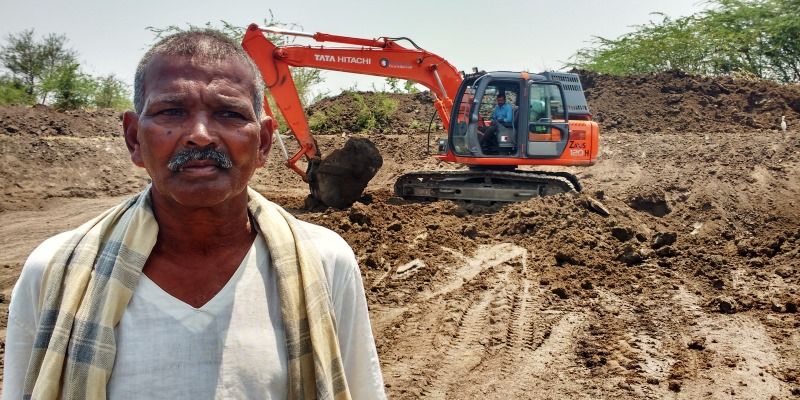Why and how farm ponds can save Indian farmers
About half of India’s population depends directly on agriculture. The severe drought prevailing in the country has caused distress in more than 250 of 600-plus districts across 11 states, affecting about 330 million people. According to Indian industry lobby group Assocham, the drought may have cost the country some Rs 6.5 trillion ($97 billion). Over 40 percent of food production in the country depends on adequate and timely rainfall. It is high time for the country to explore ways to make farming sustainable by reducing its dependency on uncertain monsoon. Constructing farm ponds to store and manage precious water better could be one of the solutions.
Even a sporadic rain is enough to bring smile on the face of desperate Indian farmers. An occasional cloudburst makes them forget all the miseries they suffered when their crops failed due to drought. With just one good year of monsoon, governments become oblivious to the agrarian crisis, and the media turns attention towards other sensational issues.

In fact, it’s this undying spirit and optimism that sustain the lives of farmers in a country that has the most unpredictable rain pattern in the world. Stray incidents of farmer suicides in distressed regions notwithstanding, life goes on as usual until another cycle of drought returns to take its toll of farmers, pushing the rural economy to the brink yet again.
What is the problem? Do we need ‘innovation’ or never-seen-before techniques to invigorate our farm sector? Do our farmers need to import best practices from elsewhere to make their lives better?
No doubt there are a number of factors that can make farming sustainable, but none of them can be as simple and elegant a solution as digging a farm pond.
People in the drought-hit regions of India, be it Marathwada, Vidarbha or Telangana, are grappling with severe water crisis this summer, sometimes even going miles to collect a few pots of drinking water. However, many farmers in North Karnataka, another perennially rain-deficient region, are growing their crops as usual and also making profits!
How is it possible?

How is it possible to cultivate crops in a region that has not received a good monsoon over many years, except for some rare showers? It’s the decision of the farmers to dig farm ponds in their lands that has made all the difference. Farm ponds are shielding them from the vagaries of drought and helping them keep their farm activity ticking.When I was travelling through some villages in Navalgund taluk of Dharwad district recently, I was pleasantly surprised to see stretches of land covered with lush green vegetation that stood in stark contrast with parched lands in immediate neighborhoods.
Farmers in around 20 villages have constructed about 800 ponds, which provide them an ability to store water during an occasional rain, and use the same to feed water to crops during the dry spells. And the success is contagious. Seeing their neighbours thrive, more farmers are going for farm ponds and it is becoming a movement of sorts at the grassroots. They have also started cultivating water-intensive but more profitable commercial crops like papaya, beyond the traditional cotton, onion, jower, etc.
A pond in the (standard) size of 100ft x 100ft x 10 ft can store water that is enough to irrigate up to four short-term crops in a five-acre area in a span of six months. And this is a huge boost for the farmers who can do wonders provided they have water.
Water is everything for farmers
“If there is no water for our crops, we have to work as daily wage laborers to make a living, irrespective of how many acres of land we own,” said Eshwarappa Shekharappa Kumbar, a 65-year-old farmer in Kadadalli, a village in Navalgund, which is one of the 135 taluks declared as drought-hit by the Karnataka government this year.

Eshwarappa is no philosopher. His experience comes from years of hardship, toiling desperately in parched farmlands under the scorching sun for years. Despite owning 25 acres of land, he worked as a farm laborer during the drought till last year. He was also forced to borrow bank loans to make both ends meet.Thanks to his decision to constrict a pond in his 16-acre land last year, he earned Rs 3 lakh profit as he could harvest up to four crops in one year. And it was for the first time that he made profits in lakhs, growing cotton, onion, wheat, maize and pulses. Encouraged by the initial success, he got another pond dug in a three-acre plot of land this year.
A common link
Eshwarappa is just one example and there are hundreds of farmers like him. And there is one common link that connects them all: Deshpande Foundation (India), headquartered in Hubli, a tier-2 city in North Karnataka.
It was Deshpande Foundation that started supporting the idea of farm ponds in 2013. With the support of Tata Trust, it decided to encourage farmers in drought-prone regions to construct ponds by providing them earthmovers and trained machine operators at a nominal cost. What began in a small way with just nine ponds in the first year became 500 ponds in 2016, taking the total number of ponds dug so far to nearly a thousand.
“Most of the machines that are in the field (about 30) today are provided by Tata Trust. Even the banks are coming forward to support us in managing our capex (capital expenditure) with their CSR funds,” explained Naveen Jha, CEO of Deshpande Foundation.
The farmers’ success with farm ponds has three key takeaways for governments and non-profit organisations that want to promote sustainable methods of agriculture in our country.
- Education and encouragement
Due to lack of awareness or their preoccupation with old and traditional practices, farmers are generally reluctant to adopt any new ideas and the challenge is to change their mindset.
Initially, Deshpande Foundation faced resistance from farmers to the initiative. They thought the idea wouldn’t work and were reluctant to part with a strip of land that is required to construct a pond. An army of field executives from the Foundation carried out awareness programmes and convinced the farmers to join the initiatives.
“When we began, we had to run after them to join the initiative. But now, they are behind us,” Naveen Jha says citing more than 500 applications received from farmers for digging ponds in just one month.
- Spreading an idea by demonstrating its impact
Seeing is believing, and it applies to farmers too. The best way to convince them about an initiative like farm pond is to demonstrate its success, in the manner the Foundation did. Seeing others thrive on farm ponds, more farmers are coming forward to dig one in their lands.
The larger objective of the Foundation is to present the entire Navalgund taluk as a model of success for the rest of India. It is for this reason that it is focusing only on one taluk, instead of doing it sporadically all over, to show the impact.
- Operational support versus direct financial help
Providing operational support to make things happen rather than providing financial help directly to the farmers is the best way to achieve success. In the case of farm ponds, farmers have to invest Rs 50,000, which almost half of actual market costs, to dig a pond. The Foundation provides machineries and trained personnel at a nominal fee to keep the operational costs down for the farmers.
The refusal to adopt a grant model, wherein the farmers would passively receive financial assistance, has made the farm pond programme a social enterprise, achieving scale and impacting a large population.
Navalgund taluk is emerging as a model for how farm ponds. The onus is now on governments and other social enterprises to spread the concept of farm ponds to all drought-prone regions of the country. When there is a proven way and the best practices, why should it be difficult to make the lives of our farmers sustainable by insulating them against uncertain rainfall and recurring droughts?
Read More –
Synergy of social enterprises can solve India’s drought problem
Meet India’s ‘water doctor’, who has turned 84 acres of barren land into a water bowl
While the country battles with drought, know how ‘farm ponds’ are bringing prosperity to farmers of Dewas, MP








![[Funding alert] Gurugram-based Bolo Indya raises $400,000 led by Inflection Point Ventures](https://images.yourstory.com/cs/2/0a385fc03e6011e999df3d1594bbde2c/Imagegtfr-1607249104762.jpg)


